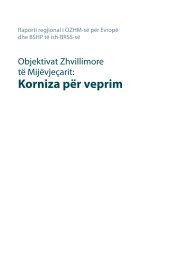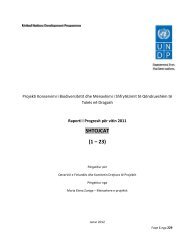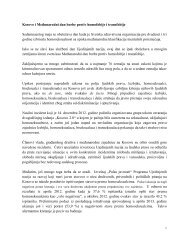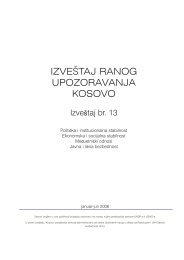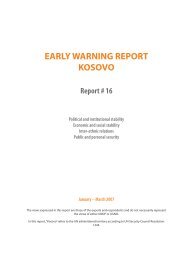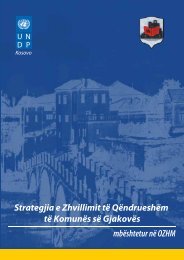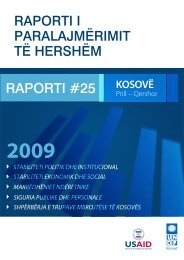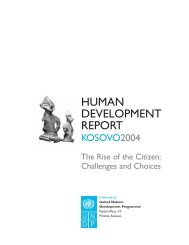Kosovo Human Development Report 2010 - UNDP Kosovo - United ...
Kosovo Human Development Report 2010 - UNDP Kosovo - United ...
Kosovo Human Development Report 2010 - UNDP Kosovo - United ...
You also want an ePaper? Increase the reach of your titles
YUMPU automatically turns print PDFs into web optimized ePapers that Google loves.
more than half of its members who are<br />
elderly faces a poverty risk of 62.3 percent<br />
higher than all other household<br />
categories.<br />
The cash benefits provided to social<br />
assistance beneficiaries are insufficient<br />
to bring them out of poverty. The<br />
minimum social assistance is 35 EUR<br />
for one family member and 75 EUR for<br />
families with seven or more members<br />
(see table 2.6), while the average salary<br />
in <strong>Kosovo</strong> is about 250 EUR. Overall,<br />
the average amount of money poor<br />
families receive per month in <strong>Kosovo</strong><br />
is approximately 60 EUR (14 EUR per<br />
member of the family). A person living<br />
on social assistance in <strong>Kosovo</strong> has<br />
in average 0.46 EUR per day to live on.<br />
This scheme was introduced in 2003<br />
and has not changed despite social<br />
stagnation and persistent poverty.<br />
The low benefits provided to social<br />
assistance beneficiaries are a result of<br />
limited funds dedicated for this segment.<br />
<strong>Kosovo</strong>’s public expenditure on<br />
social protection as a percentage of<br />
GDP is the lowest in the region, with<br />
only 3.7 percent of the GDP or 12.7<br />
percent of total institutional expenditures<br />
allocated for social protection.<br />
Furthermore, the current social<br />
protection system is characterised<br />
by low coverage of the poor. The social<br />
protection system does not reach<br />
over 75 percent of the poor and has<br />
reinforced dependency and the status<br />
quo. Only 34 percent of those who<br />
are being reached by social protection<br />
transfers are extremely poor. Targeting<br />
in the social assistance system is<br />
relatively weak and currently about<br />
a third of social assistance recipients<br />
are non-poor. Social protection<br />
is focused at the level of household,<br />
where the employment status of family<br />
members is the main factor deter-<br />
mining their eligibility and amounts<br />
of social assistance. Such a narrow set<br />
of criteria does not do justice to people<br />
in need of government support.<br />
Table<br />
2.6<br />
Levels of social assistance<br />
Family size Social assistance in EUR<br />
One member 35<br />
Two members 50<br />
Three members 55<br />
Four members 60<br />
Five members 65<br />
Six members 70<br />
Seven and more 75<br />
Source: Ministry of Labour and Social Welfare<br />
2.3<br />
Who is affected by<br />
economic and labour<br />
market exclusion?<br />
(i) Groups excluded from all factor<br />
markets (by location, education, ethnicity<br />
and gender). Exclusion from all<br />
factor markets is a largely urban phenomenon.<br />
The excluded are mainly<br />
concentrated in urban areas, specifically<br />
in secondary towns. Education<br />
levels correspond inversely to levels of<br />
exclusion. <strong>Kosovo</strong>-RAE groups are also<br />
associated with higher-than-average<br />
exclusion rates. There are major gender<br />
disparities in exclusion from all market<br />
factors, with women much more likely<br />
to be excluded from employment and<br />
business ownership.<br />
Location: the residents of all towns<br />
except for the capital Prishtinë/Priština<br />
have higher incidence of exclusion from<br />
factor markets than the overall <strong>Kosovo</strong><br />
rate. This can be explained by the fact<br />
that the majority of households living in<br />
villages own arable land, while households<br />
in the capital Prishtinë/Priština<br />
have better access to labour markets.<br />
ECONOMIC AND LABOUR MARKET EXCLUSION<br />
| 41



